|
Having a Little Fun
with Clarice Cliff
by Bob Brooke
Creative, quirky, imaginative—all goods words to describe the pottery of
Clarice Cliff, an English ceramic artist who created works from1922 to
1963. She began working in the pottery industry when she was just 13. At
first, she gilded pieces, adding gold lines on traditional wares. Once
she mastered this, she learned freehand painting at another pottery
while studying art and sculpture at the Burslem School of Art in the
evenings.
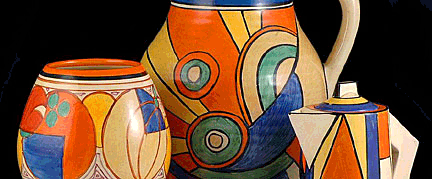
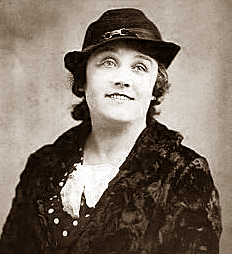 Most
young women in the Staffordshire Potteries worked for “apprentice
wages,” and after mastering a particular task, stayed with that to
maximize their income. Cliff was ambitious and acquired skills in
modeling figurines and vases, gilding, keeping pattern books and
hand painting ware, including outlining, enameling, and banding
while working as an apprentice. In the early 1920s the decorating
manager Jack Walker brought Cliff to the attention of one of the
pottery’s owners, Colley Shorter, who offered her an apprenticeship. Most
young women in the Staffordshire Potteries worked for “apprentice
wages,” and after mastering a particular task, stayed with that to
maximize their income. Cliff was ambitious and acquired skills in
modeling figurines and vases, gilding, keeping pattern books and
hand painting ware, including outlining, enameling, and banding
while working as an apprentice. In the early 1920s the decorating
manager Jack Walker brought Cliff to the attention of one of the
pottery’s owners, Colley Shorter, who offered her an apprenticeship.
A. J. Wilkinson's gave Cliff a second apprenticeship in 1924,
primarily as a “modeler” on conservative, Victorian wares. She also
worked with the factory designers John Butler and Fred Ridgway.
By 1925, she had begun modeling stylized figures, people, ducks, as
well as floral embossed Davenport ware. Eventually, the owners of
Wilkinson’s recognized her wide range of skills and, in 1927 gave
her own studio at the adjoining Newport Pottery which they bought in
1920. Here, she decorated some of the old defective “ghost,” or
white ware in her own freehand patterns. For these she used on-glaze
enamel colors which enabled a brighter palette than underglaze
colors.
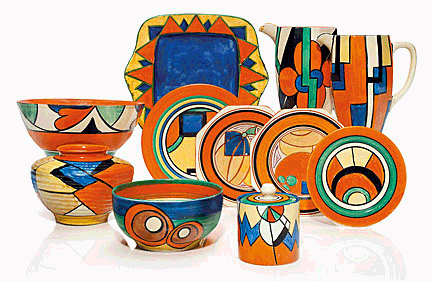
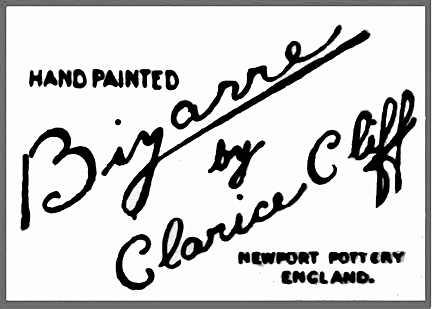 Cliff
creatively covered the imperfections in the ghost pieces in simple
patterns of triangles, in a style that she called “Bizarre.” The
earliest examples had just a handpainted mark, usually in a rust
colored paint—“Bizarre by Clarice Cliff,” sometimes with “Newport
Pottery” added underneath. To everyone’s surprise, it was an
immediate hit. Soon, a young painter named Gladys Scarlett began
helping her with the ware. Soon the company produced a more
professional “backstamp,” which displayed Cliff's facsimile
signature and proclaimed "Hand painted Bizarre by Clarice Cliff,
Newport Pottery England." Bizarre became an umbrella name for her
entire pattern range. The pottery referred to the first pieces Cliff
produced as “Original Bizarre.” By this time, Cliff's team of
decorators had grown to 70 young painters, mostly women which she
nicknamed her “Bizarre girls.” Cliff
creatively covered the imperfections in the ghost pieces in simple
patterns of triangles, in a style that she called “Bizarre.” The
earliest examples had just a handpainted mark, usually in a rust
colored paint—“Bizarre by Clarice Cliff,” sometimes with “Newport
Pottery” added underneath. To everyone’s surprise, it was an
immediate hit. Soon, a young painter named Gladys Scarlett began
helping her with the ware. Soon the company produced a more
professional “backstamp,” which displayed Cliff's facsimile
signature and proclaimed "Hand painted Bizarre by Clarice Cliff,
Newport Pottery England." Bizarre became an umbrella name for her
entire pattern range. The pottery referred to the first pieces Cliff
produced as “Original Bizarre.” By this time, Cliff's team of
decorators had grown to 70 young painters, mostly women which she
nicknamed her “Bizarre girls.”
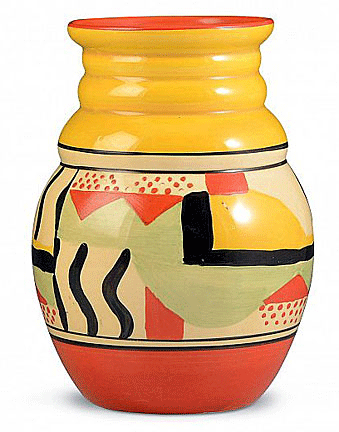 In
March 1927, Colley Shorter, one of the pottery’s owners, sent Cliff
to the Royal College of Art in Kensington, London, to study in March
and May. In
March 1927, Colley Shorter, one of the pottery’s owners, sent Cliff
to the Royal College of Art in Kensington, London, to study in March
and May.
After her studies at the Royal College of Art, Cliff’s pottery
shapes from 1929 onwards had a more Art Deco influence, often
angular and geometric. Abstract and cubist patterns appeared on
these shapes, such as the 1929 Ravel on Cliff's Conical-shaped ware,
which was an abstract leaf and flower pattern named after the
composer. Ravel was another of Cliff's Bizarre shape ideas which
became popular in the 1930s.
In 1928 Cliff produced a simple, hand painted pattern of Crocus
flowers in orange, blue and purple, each flower being constructed
with confident upward strokes. Then she added green leaves by
holding the piece upside down and painting thin lines amongst the
flowers. The wares vibrant colors instantly produced large sales.
Crocus was unusual in that it was produced on both tableware, tea
and coffeeware, and 'fancies', novelty items made primarily as gift
ware. The pattern had many color variations, including Purple
Crocus, Blue Crocus, Sungleam Crocus, and Spring Crocus. It was even
produced after the war, the final pieces with Clarice Cliff marks
being made in 1963.
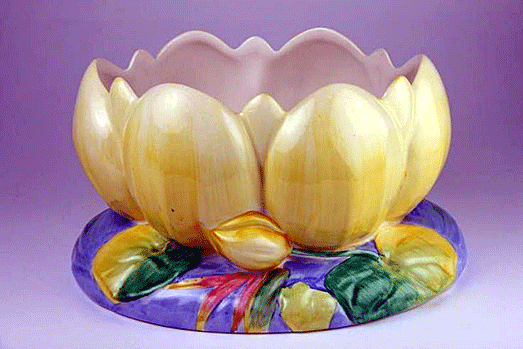
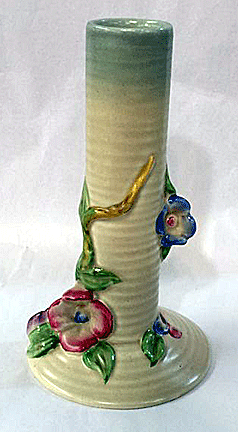 But
in 1929 at the same time as she started producing her colorful
cubist and landscape designs, Cliff's modeling took on a new style,
influenced by European Art Deco designers Désny, Tétard Freres,
Josef Hoffmann and others, that she had seen in design journals. But
in 1929 at the same time as she started producing her colorful
cubist and landscape designs, Cliff's modeling took on a new style,
influenced by European Art Deco designers Désny, Tétard Freres,
Josef Hoffmann and others, that she had seen in design journals.
In the mid 1930s, tastes changed and heavily modeled ware came into
vogue. The My Garden series issued from 1934 onwards led the way,
with small flowers modeled as a handle or base on more rounded
shapes. These were fully painted in bright colors. Cliff covered the
body of her wares in thin color washes—“Verdant' was green,
“Sunrise” yellow, and so on. The vessels included vases, bowls,
jugs, even a biscuit barrel (cookie jar), and became very popular as
gift ware. The pottery produced it in more muted colors until the
start of World War II in 1939.
The company never exported Clarice Cliff’s visually explosive
designs of the 1920s and '1930s from her Staffordshire-based studios
to the United States. However, it was Americans, including a number
of celebrities, who became the most competitive buyers of her
way-out wares. Further outrageous patterns, vividly colored, such as
Melon and Circle Tree appeared in 1930.
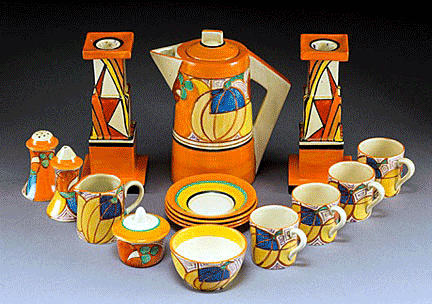
 Experts
believe the avant-garde art museums and galleries of Paris during
the late 1920s inspired Cliff’s nonconformist shapes and
kaleidoscopic colors. British consumers were both awestruck and
dumbfounded by the unashamedly Cubist influences displayed in
Cliff's post-Paris ceramics. It was the boldest, brightest, wildest
stuff they had ever seen. Queen Mary reportedly had another word for
it: "Ghastly!" But in time, even Her Majesty fell under its spell
and bought a tea set, albeit in one of the more conservative
patterns. Experts
believe the avant-garde art museums and galleries of Paris during
the late 1920s inspired Cliff’s nonconformist shapes and
kaleidoscopic colors. British consumers were both awestruck and
dumbfounded by the unashamedly Cubist influences displayed in
Cliff's post-Paris ceramics. It was the boldest, brightest, wildest
stuff they had ever seen. Queen Mary reportedly had another word for
it: "Ghastly!" But in time, even Her Majesty fell under its spell
and bought a tea set, albeit in one of the more conservative
patterns.
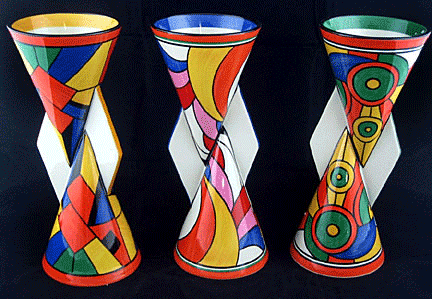 It
was Cliff's fearlessness and disregard for convention that
unwittingly produced the designs that are now most desirable to
collectors. Clarice Cliff’s work is all about pattern and shape, and
together these alone dictate the prices today. The rule: A geometric
pattern like Football or Sunray can make up for a frumpy shape, and
conversely, an abstract shape, such as the angular Biarritz, can
offset a ho-hum floral. If a collector can find a piece that
combines a coveted pattern with an offbeat shape, they’ve hit the
jackpot. It
was Cliff's fearlessness and disregard for convention that
unwittingly produced the designs that are now most desirable to
collectors. Clarice Cliff’s work is all about pattern and shape, and
together these alone dictate the prices today. The rule: A geometric
pattern like Football or Sunray can make up for a frumpy shape, and
conversely, an abstract shape, such as the angular Biarritz, can
offset a ho-hum floral. If a collector can find a piece that
combines a coveted pattern with an offbeat shape, they’ve hit the
jackpot.
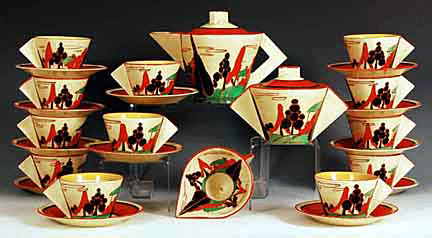
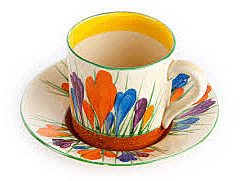 Most
collectors buy Clarice Cliff's designs to own and enjoy. Basically,
any Clarice Cliff piece in a rare pattern is a hot ticket at
auction, bringing in competitive bids at stratospheric prices,
whether it's an oversized wall charger or a humble jam pot. Most
collectors buy Clarice Cliff's designs to own and enjoy. Basically,
any Clarice Cliff piece in a rare pattern is a hot ticket at
auction, bringing in competitive bids at stratospheric prices,
whether it's an oversized wall charger or a humble jam pot.
A single-handled lotus vase, which look similar to ancient Egyptian
water jugs, sold for t $7,475, both in the Honolulu and Latona
Dahlia patterns. A 6-inch Fantasque series 265 vase in the
seldom-seen Green House pattern brought even more at $9,970, and a
Bizarre series stepped vase in the highly coveted Tennis motif set a
record for a Clarice Cliff vase at auction when it sold to an
American collector for $18,276!
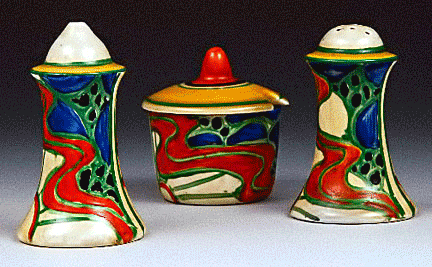
Rare combinations of shape and pattern attract very high prices at
auction. The world record price for a piece of Clarice Cliff is held
by Christie's, South Kensington, London, which sold an 18-inch
charger in the May Avenue pattern for $53,504. Shortly after this
the same auction house sold an 8-inch vase in Sunspots for $27,091.
"Having a little fun at my work does not make me any less of an
artist, and people who appreciate truly beautiful and original
creations in pottery are not frightened by innocent tomfoolery,"
said Cliff in an interview.
< Back
to Collectibles Archives
Next Article >
|
